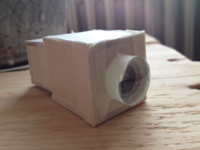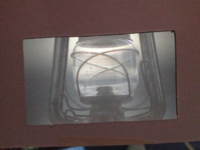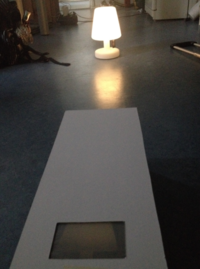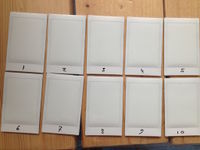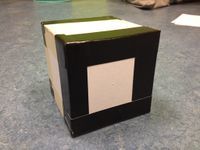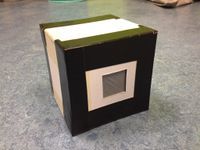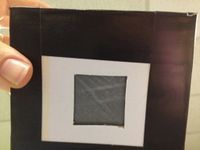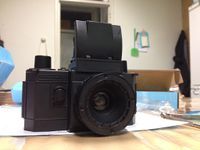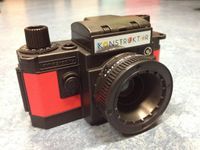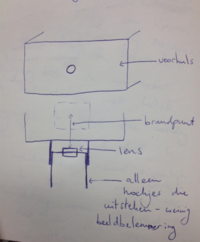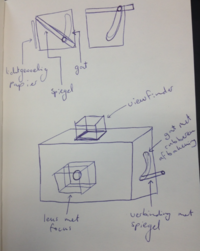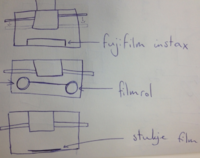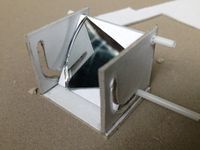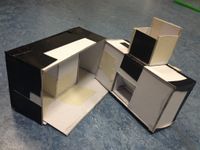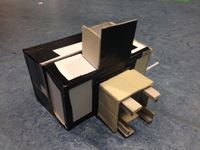Difference between revisions of "User:OUK"
| Line 2: | Line 2: | ||
0889892@hr.nl | 0889892@hr.nl | ||
| + | |||
| + | [[User:OUK/page_that_doesn't_exist]] | ||
===Week 1=== | ===Week 1=== | ||
Revision as of 10:24, 13 September 2016
Manouk Moreau
0889892@hr.nl
User:OUK/page_that_doesn't_exist
Week 1
First question from this course: why am I a maker?
Good question. Where did I find the ego to say: I’m going to make stuff that will make other people happy too? Well, happily for me there’re so many human beings on this planet, that there’ll always be someone who will kind of like it (like my mom).
But seriously: I believe that if you’re a, in my case filmmaker (or designer, or artist), you have a leading role – you show an example for other people how to live. Kind of. In the case that I would never let anyone smoke in my film for example, or never curse with harsh diseases or anything in that kind. You’re giving an example of how to be good. But, like I said: kind of. I hope that I will make my little world better some day, by giving my definition of good to other people. I believe that that’s the reason that I chose for going to an art school, instead of going to study something like economics (in which I would suck, probably). But if I will never change anything, that’s okay too – as long as I believed in that what I did, was the right thing. Like being vegetarian or doing voluntary work: making single little changes.
But am I really a maker? I don’t think so, jet. I grab a digital camera, I look at the script I wrote and start shooting. It’s not really a craft I’m making except for the writing; I don’t even know, if I have to be honest, how a camera exactly works. Than what am I doing with the latest model of a digital SLR camera? Crafting as filmmaker: what do I know from the technical aspects? I am reproducing others films and my own films, all through Internet, all digital. How does it work non-digital, analogue?
By this, I’m happy with our subject: drawing & printing, reproduction. As a filmmaker you are reproducing all the time. How to do that from scratch.
Week 2
Camera Obscura | lens
2,5 centimeter = vergrootglas met diameter 2 cm
Camera Obscura | box
Voorplaat buitenste box: 3 x 3 cm
Zijplaten buitenste box: 3 x 4 cm
Zijplaten binnenste box: 2,7 x 4,5 cm
Camera Obscura | proces
Camera Obscura | eindresultaat
Camera Obscura SLR | lens
31 centimeter = vergrootglas met diameter 10 cm
Camera Obscura SLR | box
Box: 15 x 15 x 35 cm Spiegel: 15 x 15 cm
Camera Obscura SLR | proces
Camera Obscura SLR | eindresultaat
Week 3
After experiments with lenses and stuff, I thought it would be nice to play a bit with lightsensitive paper. I made my room dark, opened a box with Fujifilm Instanx films, and put them behind the mirror of the camera obscura SLR. Only thing I missed... I am nightblind. The room, where I didn't see a thing, shall have been very light for the paper. Oops.
After this odd experiment, I went searching on the internet. What was going to be my next step? For next week we got to find a project which is 50% craftmanship, 50% machine-made. In the researching, I found the Konstruktor DIY 35 MM SLR Camera, which I became excited off; by making such a camera myself, I could see how to make such a already easy to make camera, more easy - and how does it work exactly?
BUT: what I found also in this research, was the pinhole camera. I didn't think of a camera obscura without a lense - I didn't even think it was possible. Silly me. So, I couldn't sleep before I made one.
Okay, it may be not too clear on this picture - but you can see the light on my wall. Upside down, from which I thought was because of the lenses.
After this, I could sleep peacefully.
Week 4
For this week, we needed to make something that was 50% machine and 50% craft. I was thinking how I could make my own camera work, and went on the internet... And found the Konstruktor. A camera which you can make yourself from the machine (perfect: machineswork matched with my own hands), so I could take a close look how these makers/designers made this camera.
So, coming back on the 50%-50% thing... Ofcourse, I know that this isn't exactly 50-50. There had been so many hands on this camera to make the design easier and easier, before a machine made it and then my hands went on it.
Last week, I spoke to a cameradesigner, who looked me really seriously in the eye, when he said: 'It cost way more time to make a simple design. That's why lots of camera's in the stores are way more difficult then they would have to be - but it takes time, and those brands just want to put those cameras on the market as fast as they're working.'
But, my plan with this camera, was to look at how they made it, and learn how I could make it even more easy, handcrafted. I came to the conclusion that I didn't want a camera with al those buttons - I couldn't make such a thing in this short time. Down here, you see my sketches for the next camera.
Week 5
This week I made my own not-very-functional camera, just to show how it works; if you look on the internet, there are a lot of pinhole camera's you can make yourself. It seems like nobody makes SLR camera's on his own. This camera shows how simple a SLR camera really is build. Next to this camerabuilding, I decided to make a short documentairy about the camerabuilder I wrote about in 'Week 4' (with the quote). He has the same idea as me in camerabuilding; showing how easy it actually is, to make other people also experiment with it.
Week 6
Well, I have no clue what I'm going to 'push to the limit' as 'material', but I do have an idea about makership.
What is a maker for me?
Making is a consciousness of what kind of materials and what kind of tools you are working with – to make stuff. Conceptual or non-conceptual doesn’t matter that much in this sense; it’s the deepening in the project, which makes it a craft. It’s not just having an idea and making it to your first thoughts – it’s the process of thinking, visualizing and experimenting on it with different materials, colours, or any other ways to experiment with. That means you’re a maker when you design coffee cups (with the thinking process), and you’re a maker when you create coffee cups (the experimenting with materials process) – but in a deeper way then making a thought.
Why did I choose to become a maker?
- I chose for the art academy because I wanted to make a change. That can be an open design / that can be an ideal in film / that can be teaching people about craft in film.
- It gives me satisfaction when people see what I’m trying to say in film or design.
- It gives me even more satisfaction when people think further about my opinion, which I placed in my film - and make it their own.
- I always cared a lot more about the environment than about capitalism.
Who am I as a maker?
At the beginning of this quartal, I was forced to ask myself a question: am I a maker? I came to the conclusion that I wasn’t - yet. Not that I haven’t made any work; I have made quite a couple of short movies. In this sense film is quite a craft; just like ceramics you can mould your storytelling in different ways to get different results. But the thing was that I wrote that stories down (deepening in the stories with characters, storylines and moral), and after that I grabbed a digital camera and I started shooting. My opinion in this question was: ‘How can I be a maker, if I don’t really understand the tools I am working with?’
“It’s not really a craft I’m making except for the writing; I don’t even know, if I have to be honest, how a camera exactly works. Than what am I doing with the latest model of a digital SLR camera? Crafting as filmmaker: what do I know from the technical aspects? […] How does it work non-digital, analogue?” (‘Who Am I As A Maker?’, Manouk Moreau, 11 February 2016)
In the case of the camera, indeed – I wasn’t really shore about the working of such a thing. When I realised this, I knew I wanted to use this practise for exploring the camera and film camera. To understand my tools and with that, become a total maker in my specialization – film.
What do art schools do with craft?
Art schools are more about the crafts than any other schools – the MBO schools with for example wood- and craftsmanship studies, HBO and Master studies for studying the past of art plus the autonomous art studies. It’s about exploring and trying, finding new ways and new materials. Exploring the unknown. That doesn’t mean the future – it’s mostly inspirited by old ways. The quote of Eric Micha’el Leventhal and lots of sortlike quotes tell the whole story: “You invoke a new future when you envision your past in the light of your present.” And because artists and builders and makers are working to build the spaces of the future, we need to study the past. Including old ways like working with metals, woods, fabrics and ceramics. Or for my example: the beginning of film.
Maker Bill of Right: do I agree?
I like the access to hack products. Not necessarily to change the product – I just want to know how things are made. Not wanting to make it better, or worse, or different… it’s just the deepening in the products you’re working with. With a lot of products like laptops, telephones and camera’s, this isn’t even possible – the companies want you to send your product to them to fix it when it’s broken. You can’t fix it yourself. Your guarantee will be broken if you break a sticker, for example. This means the product is finished – it can’t get any better, it has a patent of an inventor and there it stops. There, you can say, stops the ‘inventor’ being a maker; he doesn’t want to improve the product ‘cause it has to make money right from that moment. A camera builder told me that the designs of SLR camera’s in the shops like Canon and Nikon, can be build way easier and do the same thing – but designers don’t get enough time to make it any easies, because they have to finish it for a deadline to get it on the market. What does the designer has to hide, if he has a patent on the product? Hackers will find their way through the design to make it their own anyway. But like I said – companies want you to send the product to them if it’s broken; so they could ask more money for the fixing, because their the only ones doing it. Instead of this easy money-grabbing technique, they could open up the design and design creative tools to sell next to the original product, for hackers to change it to their preferences. They will get money for being creative – instead of taking a forced fixing-place. That would be, in my opinion, a fair way of getting money.
Maker Movement: Hack That Shit!
Linus Torvalds: “The future is to open source everything.”
Creative Commons, Wikipedia and a lot of limpidity in closed projects as biotechnical research from CAMBIA came into this world because of the open source. What the difficulty is with open source is that nobody gets paid. You can download a design for free, print it with a 3D-printer or a laser cutter, hack the product and put it back on the open source. The product will become better because of all the people with different disciplines looking at it. But: bakeries still want money for the bread they’re baking. How can you buy that bread when you don’t get money for what you make? That’s why the people who ‘do’ open source, do it next to their job. Society needs a different way of living, to make open source possible to live from. But for now, it’s just the deepening way for makers in their creative process, in a free way.

